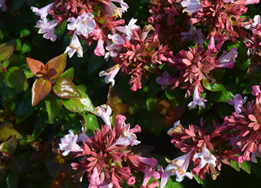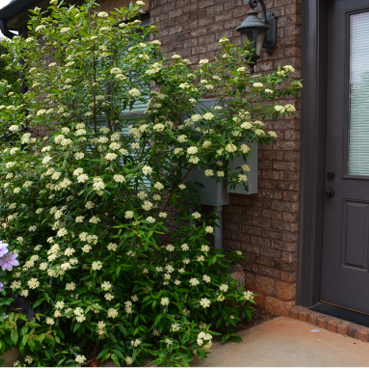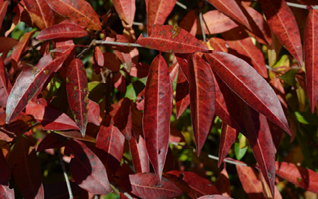
Ed Overdevest, president and co-owner of Overdevest Nurseries, Bridgeton, New Jersey, asked if I would present a lecture at the company’s open house in early October 2023. Ed requested a theme centering on time-honored plants and potential improvements with minimal time allocated to hydrangeas. Sounded like a challenge and I accepted. Bonnie and I arrived in Bridgeton on Oct. 2 and enjoyed the personal tour of the nursery. What a beauty! Clean, organized, uniform quality, thoughtful water management, display gardens and great people. Ed, Gail and their son Ryan own and manage a phenomenal nursery. Oct. 3 was the open house with displays of new plants, equipment, processes like propagation, potting, water management and wagon tours of the nursery. Bonnie and I heard nothing but positive comments from the retailers who attended. All praised the plant diversity and the consistent high quality when arriving at retail.

at Overdevest's trial garden

The tour ended with a reception in the trial garden area. Survey flags were given to attendees to evaluate their favorite plants, principally hydrangeas, of which there were numerous numbered accessions and known cultivars of H. paniculata. The two primary flag accumulators were Love-A-Lot and Ruby Snow, both introductions from the syn-RG group of which Overdevest is a member. I know for certain that without labels, many of the cultivars could never be separated. Remember Ed told me to go light on hydrangeas.
The lecture was scheduled for 4:30 and off I spewed with what follows. The article parallels the presentation except for an expanded treatise on several plants. A brief discussion of my Georgia and the PII breeding company programs set the table for the presentation.

Hydrangea improvements: What’s needed
I believe the dark purple foliage Eclipse from Bailey is unique. Breeding for the purple leaf trait started at UGA when ‘Lilacina’ seedlings were treated with colchicine, and several turned degrees of purple.
H. arborescens- Better “reds.” Compact, strong-stemmed whites. Have returned to the drawing board and now have the third generation of red selections from ~330, 2023 seedlings (photo). The Achilles’ heels with the red H. arborescens are weak stems and bacterial leaf scorch.

H. macrophylla- Hardiness, hardiness, hardiness. Reliable rebloom. Survive early fall freezes, midwinter lows and late winter/spring freezes. Cercospora immunity.
H. paniculata- Too many. How to differentiate? New colors on horizon. In contact with a Virginia breeder who has a transformational color range in the inflorescences. (Editor’s note: watch for more about this in our March issue)
H. serrata - Hardiness genes. A zone hardier. Now used more often in breeding. Tim Wood, Spring Meadow, figured this out with the introduction of the Tuff Stuff series, followed by Can Do! and others. PII added pretty foliage colors to H. macrophylla × H. serrata hybrids using ‘Mountain Mania’, ‘Mountain Mojo’, and ‘Rivendell’ (photo). Only lacecap inflorescences resulted from crosses.
Putting hydrangeas in the rear-view mirror, here are some advances in other genera.
Flowering shrubs



Abelia × grandiflora- Abelias are extremely popular with Kaleidoscope leading the parade. PII is breeding for compact habits, colorful foliage, prolific flowering, and strong root systems. Have pretty ‘Rose Creek’ selections (Rose Creek-01-23), (photo above). Milky Way (aka ‘White Surprise’, Angel’s Blush) has cream white, green centered foliage, minimal reversions, compact spreading habit. Brillantina, Funshine, Poco Loco, Tres Amigos and Mucho Gusto are relatively new introductions from Spring Meadow/Proven Winners ColorChoice. Star Roses and Plants introduced Apple Perfection and Peach Perfection. Southern Living Plants introduced Suntastic Peach and Suntastic Pink circa 2022. I suspect the introductions will continue as Abelia × grandiflora is leading the woody flowering pollinator shrub revolution.

Buddleia- I considered Buddleia a neutered genus but then pollinators started to drive the flowering shrub bus. Consequently, up pop Pugster, Butterfly Candy, Buzz, Dapper, Flutterby and other series. Sterility is needed. I have collected seed of every Pugster with only Pugster Blue completely sterile. Resilience under overhead water and extreme heat is a priority. PII has compact, prolific flowering (white, lavender, pink, purple), dark green foliage selections. Hoping for yellow-flowered seedlings in 2024 from F2 ‘Honeycomb’ hybrids. Lilac Punch flowered the entire summer into early November at PII (photo, pg. 25). Buddleia seeds germinate without pretreatment and flower in the first season, allowing for quick, easy and often redundant introductions.

Fothergilla × intermedia ‘Malone’- Lustrous dark green foliage developing consistent maroon to red fall color (photo). It is easy to root and overwinter. The original 30-year-old plant is 6 feet by 5 feet. Newer Fothergilla include Legends of the Small and Legends of the Tall. The latter is similar to ‘Mt. Airy’ in all respects. The U.S. National Arboretum shared 12 of ~26 wild-collected accessions with PII. Mix of true F. gardenii, F. × intermedia, and F. major. I did not find anything better than ‘Mt. Airy’ and disposed of the collection. Bobby Green, Fairhope, Alabama, shared a F. gardenii selection, at that time named ‘Redneck Nation’ (photo), resistant to leaf spot (Pseudocercospora sp.) with consistent yellow, orange and red fall color. The summer foliage is beautiful, dusty blue green and more refined than the current commercial offerings. It deserves everyday commercial status. Estimate 3 feet by 3 feet. It is extremely easy to root. In later correspondence, (December 2023), Bobby said Dr. Ranney considered it a new species (a diploid) and named it F. milleri ‘Redneck Nation’. It was discovered in a small population on the Alabama-Florida border by Dr. Ron Miller, Pensacola, Florida. The Nation in ‘Redneck Nation’ comes from Fred Nation who collected three small cuttings and gave them to Bobby to propagate.

Viburnum nudum ‘Little Cherub’- Compact, rounded (2 to 3 feet), large white inflorescences, lustrous dark green foliage, pink-blue fruits. U.S. National Arboretum introduction in 2022 (photo). Outstanding garden shrub. Viburnums do not elicit great enthusiasm. PII and my UGA program bred/introduced ‘Emerald Luster’, ‘Susy’, Pearlific, Spring Lace, and Opening Day. None have changed the course/trajectory of nursery commerce. An unsung V. nudum is var. angustifolium with narrow lance-shaped leaves, beautiful red-purple fall color, and self-fruiting ability. The plant grows to 10 feet high and is easily maintained at 5 to 6 feet with timely pruning. One of the best plants in the Dirr garden for colorful fruit (October) and late November-December fall color.




Explore the February 2024 Issue
Check out more from this issue and find your next story to read.
Latest from Nursery Management
- John Ruter shares UGA's latest woody and herbaceous ornamental plant breeding projects
- Conor Foy joins EHR's national sales team
- Pantone announces its 2026 Color of the Year
- Syngenta granted federal registration for Trefinti nematicide/fungicide in ornamental market
- Get to know Kayela Aeppli
- HILA 2025 video highlights: John Gaydos of Proven Winners
- Q&A with Justin Bartlett
- Be the best choice





